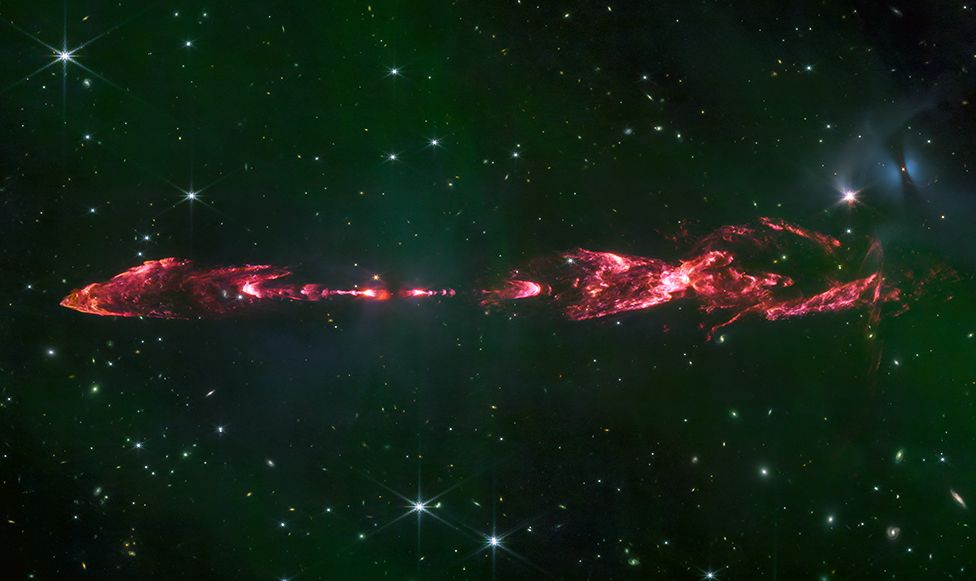ARTICLE AD BOX
 Image source, NASA/ESA/CSA/M. McCAUGHREAN & S. PEARSON
Image source, NASA/ESA/CSA/M. McCAUGHREAN & S. PEARSON
Moving at the speed of light, it would take about 1.6 years to travel the length of HH212's jets
By Jonathan Amos
Science correspondent
Imagine you could go back in time 4.6 billion years and take a picture of our Sun just as it was being born. What would it look like?
Well, you can get a clue from this glorious new image acquired by the James Webb Space Telescope (JWST).
Towards the centre of this object, called HH212, is a star coming into existence that is probably no more than 50,000 years old.
The scene would have looked much the same when our Sun was a similar age.
You can't actually see the glow from the protostar itself because it's hidden within a dense, spinning disc of gas and dust.
All you get are the pinky-red jets that it's shooting out in polar opposite directions.
HH212 is sited in Orion, close to the three brilliant stars that make up the "belt" of the mythical hunter that gives the constellation its name. The distance from Earth is about 1,300 light-years.
Physics suggests those dramatic outflows of gas are the means by which the nascent star regulates its birthing.
"As the blobby ball of gas at the centre compacts down, it rotates. But if it rotates too fast, it will fly apart, so something has to get rid of the angular momentum," explained Prof Mark McCaughrean.
"We think it's jets and outflows. We think that as all the material shrinks down, magnetic fields are pulled together and then some of the material coming in through the disc gets captured on magnetic fields and is thrown out through the poles. That's why we call these structures bi-polar," the European Space Agency senior scientific advisor told BBC News.
The pinky-red colour denotes the presence of molecular hydrogen. That's two hydrogen atoms bonded together (hence the "HH" in the protostar's name). Shockwaves are moving through the outflows, energising them and making them glow brightly in this Webb picture, which was captured predominantly at the infrared wavelength of 2.12 microns (that's the second part of the protostar's name!).
The image of HH212 was acquired by JWST's Near Infrared Camera (NIRCam). You can't see the protostar itself because it's obscured by a dense, infalling disc of gas and dust. There are a few mature stars in the field of view, but most of the points of light are far-distant galaxies.
In the annotated picture above, look closely at the left and right jets, and trace the knots of brightness in each of them. Count the bowshocks - where faster material has crashed into slower material just ahead of it.
The structures are remarkably symmetric... except there appears to be an additional, albeit very messy bowshock on the right.
In fact, there's probably a complementary bowshock on the other side. There are certainly pinky hints of it in a wider version of this Webb image. It's just that the density of gas and dust in space in that direction is thinner and so there's less material to excite and so the shock structure appears much more diffuse.
Astronomers have been studying HH212 for 30 years, taking pictures every now and then to see how it's changed. As you might expect from the Webb super telescope, its new view is 10 times sharper than anything we've had before and will enable scientists to delve deeper into the processes that drive star formation.
A nice feature is to run together the entire image history to make a movie, to see how elements in the jet structures change over time. Repeat observations mean you can also gauge the speed at which those elements are moving - at 100km per second and more.
Watch: See how the structure of HH212 has changed since being viewed in 2000
I said the HH stood for molecular hydrogen, and it does. But it also stands for Herbig-Haro, after George Herbig and Guillermo Haro, who did the pioneering work on this type of object in the 1940s and 50s.
They would no doubt be amazed by the capabilities of JWST. It's not just the sharpness of image that Webb can achieve with its 6.5m primary mirror, it's also the breadth of colour its instruments can now detect that makes the telescope so special.
"As we said, the main wavelength for looking at these things - for looking at shocked molecular hydrogen - is 2.12 microns, or roughly four times longer than the mid-visible. But for the first time, we now have a good colour image of this particular object because we're able to observe it at other wavelengths that you just couldn't see from ground telescopes. And that will help us get into what's really happening in the jets," said Prof McCaughrean.
Webb was intended to be transformative in many fields of astronomy, and the study of Herbig-Haro objects has definitely benefitted.
Look below and you can marvel at HH212's cousin, called HH211. This object, located in the Perseus constellation, is even younger, again measured in mere thousands of years. To think our Sun started out like this.
Image source, NASA/ESA/CSA/T. RAY ET AL
Image caption,HH211 is younger. Like its cousin, the jets are expanding at a rate of roughly 100km/s
JWST is a joint venture between the US, European and Canadian space agencies.

 1 year ago
67
1 year ago
67








 English (US) ·
English (US) ·